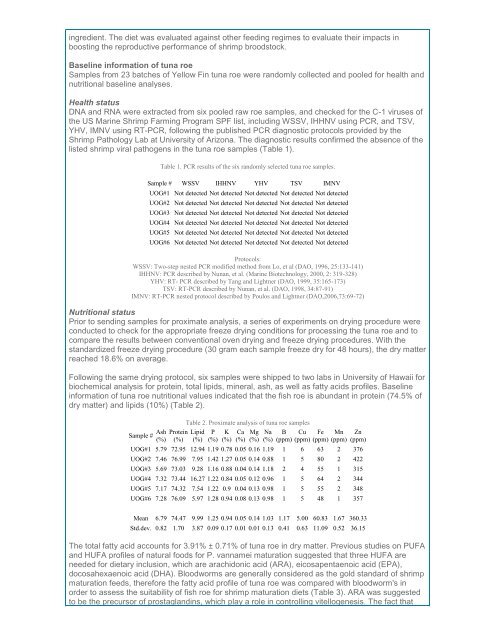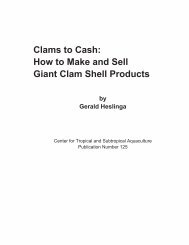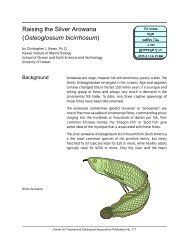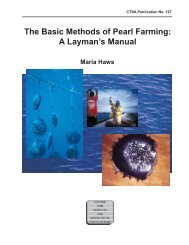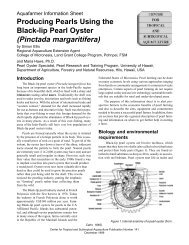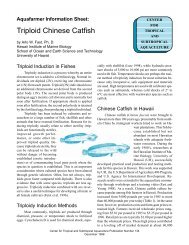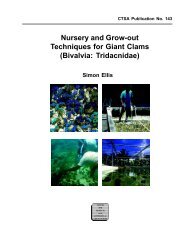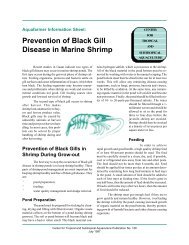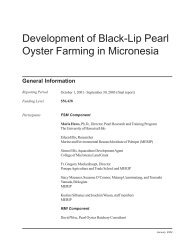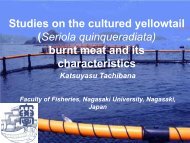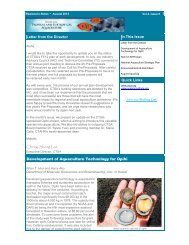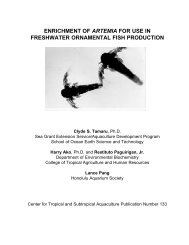Letter from the Director Cheng-Sheng Lee In This Issue ... - CTSA
Letter from the Director Cheng-Sheng Lee In This Issue ... - CTSA
Letter from the Director Cheng-Sheng Lee In This Issue ... - CTSA
- No tags were found...
You also want an ePaper? Increase the reach of your titles
YUMPU automatically turns print PDFs into web optimized ePapers that Google loves.
ingredient. The diet was evaluated against o<strong>the</strong>r feeding regimes to evaluate <strong>the</strong>ir impacts inboosting <strong>the</strong> reproductive performance of shrimp broodstock.Baseline information of tuna roeSamples <strong>from</strong> 23 batches of Yellow Fin tuna roe were randomly collected and pooled for health andnutritional baseline analyses.Health statusDNA and RNA were extracted <strong>from</strong> six pooled raw roe samples, and checked for <strong>the</strong> C-1 viruses of<strong>the</strong> US Marine Shrimp Farming Program SPF list, including WSSV, IHHNV using PCR, and TSV,YHV, IMNV using RT-PCR, following <strong>the</strong> published PCR diagnostic protocols provided by <strong>the</strong>Shrimp Pathology Lab at University of Arizona. The diagnostic results confirmed <strong>the</strong> absence of <strong>the</strong>listed shrimp viral pathogens in <strong>the</strong> tuna roe samples (Table 1).Table 1. PCR results of <strong>the</strong> six randomly selected tuna roe samples.Sample # WSSV IHHNV YHV TSV IMNVUOG#1 Not detected Not detected Not detected Not detected Not detectedUOG#2 Not detected Not detected Not detected Not detected Not detectedUOG#3 Not detected Not detected Not detected Not detected Not detectedUOG#4 Not detected Not detected Not detected Not detected Not detectedUOG#5 Not detected Not detected Not detected Not detected Not detectedUOG#6 Not detected Not detected Not detected Not detected Not detectedProtocols:WSSV: Two-step nested PCR modified method <strong>from</strong> Lo, et al (DAO, 1996, 25:133-141)IHHNV: PCR described by Nunan, et al. (Marine Biotechnology, 2000, 2: 319-328)YHV: RT- PCR described by Tang and Lightner (DAO, 1999, 35:165-173)TSV: RT-PCR described by Nunan, et al. (DAO, 1998, 34:87-91)IMNV: RT-PCR nested protocol described by Poulos and Lightner (DAO,2006,73:69-72)Nutritional statusPrior to sending samples for proximate analysis, a series of experiments on drying procedure wereconducted to check for <strong>the</strong> appropriate freeze drying conditions for processing <strong>the</strong> tuna roe and tocompare <strong>the</strong> results between conventional oven drying and freeze drying procedures. With <strong>the</strong>standardized freeze drying procedure (30 gram each sample freeze dry for 48 hours), <strong>the</strong> dry matterreached 18.6% on average.Following <strong>the</strong> same drying protocol, six samples were shipped to two labs in University of Hawaii forbiochemical analysis for protein, total lipids, mineral, ash, as well as fatty acids profiles. Baselineinformation of tuna roe nutritional values indicated that <strong>the</strong> fish roe is abundant in protein (74.5% ofdry matter) and lipids (10%) (Table 2).Sample # Ash Protein Lipid(%) (%) (%)Table 2. Proximate analysis of tuna roe samplesP(%)K(%)Ca(%)Mg(%)Na(%)B(ppm)Cu(ppm)Fe(ppm)Mn(ppm)Zn(ppm)UOG#1 5.79 72.95 12.94 1.19 0.78 0.05 0.16 1.19 1 6 63 2 376UOG#2 7.46 76.99 7.95 1.42 1.27 0.05 0.14 0.88 1 5 80 2 422UOG#3 5.69 73.03 9.28 1.16 0.88 0.04 0.14 1.18 2 4 55 1 315UOG#4 7.32 73.44 16.27 1.22 0.84 0.05 0.12 0.96 1 5 64 2 344UOG#5 7.17 74.32 7.54 1.22 0.9 0.04 0.13 0.98 1 5 55 2 348UOG#6 7.28 76.09 5.97 1.28 0.94 0.08 0.13 0.98 1 5 48 1 357Mean 6.79 74.47 9.99 1.25 0.94 0.05 0.14 1.03 1.17 5.00 60.83 1.67 360.33Std.dev. 0.82 1.70 3.87 0.09 0.17 0.01 0.01 0.13 0.41 0.63 11.09 0.52 36.15The total fatty acid accounts for 3.91% ± 0.71% of tuna roe in dry matter. Previous studies on PUFAand HUFA profiles of natural foods for P. vannamei maturation suggested that three HUFA areneeded for dietary inclusion, which are arachidonic acid (ARA), eicosapentaenoic acid (EPA),docosahexaenoic acid (DHA). Bloodworms are generally considered as <strong>the</strong> gold standard of shrimpmaturation feeds, <strong>the</strong>refore <strong>the</strong> fatty acid profile of tuna roe was compared with bloodworm's inorder to assess <strong>the</strong> suitability of fish roe for shrimp maturation diets (Table 3). ARA was suggestedto be <strong>the</strong> precursor of prostaglandins, which play a role in controlling vitellogenesis. The fact that


